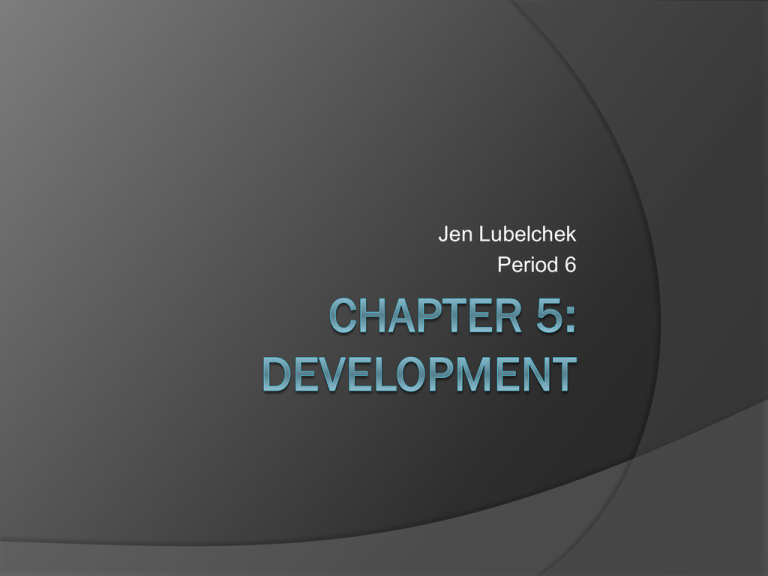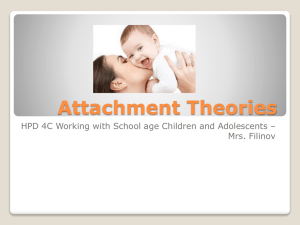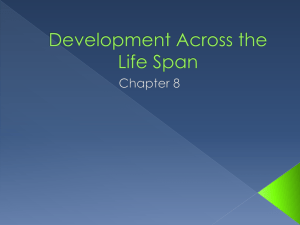
Jen Lubelchek
Period 6
Developmental Psychology
a branch of psychology that studies
physical, cognitive, and social change
throughout the life span
Issues that Developmental
Psychologists Study
Nature/nurture: How do genetic
inheritance (our nature) and experience
(the nurture we receive) influence our
development?
Continuity/stages: Is development a
gradual, continuous process like riding an
escalator, or does it proceed through a
sequence of separate stages, like climbing
rungs on a ladder?
Stability/change: Do our early personality
traits persist through life, or do we become
different persons as we age?
When men and women start
producing egg cells
Women were born producing eggs
Men start producing sperm at puberty
Definition of zygote
Zygote: the fertilized egg; it enters a 2week period of rapid cell division and
develops into an embryo
Definition of Embryo
Embryo: the fertilized egg; it enters a 2week period of rapid cell division and
develops into an embryo
Definition of Fetus
Fetus: the developing human organism
from 9 weeks after conception to birth
Definition of placenta
Placenta: which formed as the zygote’s
outer cells attached to the uterine wall,
transfers nutrients and oxygen from
mother to fetus. The placenta also
screens out many potentially harmful
substances
Definition of teratogens
Teratogens: agents, such as chemicals
and viruses, that can reach the embryo
or fetus during prenatal development
and cause harm
Smoking mothers
If she is a heavy smoker, her fetus may
receive fewer nutrients and be born
underweight and at risk for various
problems
Definition of Fetal Alcohol
Syndrome
Fetal Alcohol Syndrome: physical and
cognitive abnormalities in children
caused by a pregnant woman’s heavy
drinking. In severe cases, symptoms
include noticeable facial misproportions
Rooting Reflex
When something touches their cheek,
babies turn toward that touch, open their
mouth, and vigorously root for a nipple.
Finding one, they automatically close on
it and begin sucking—which itself
requires a coordinated sequence of
reflexive tonguing, swallowing, and
breathing
William James
The pioneering American psychologist
William James presumed that the
newborn experiences a “blooming,
buzzing confusion.”
Definition of Habituation
Habituation: decreasing responsiveness
with repeated stimulation. As infants
gain familiarity with repeated exposure
to a visual stimulus, their interest wanes
and they look away sooner
Novelty Preference Procedure
In the novelty preference procedure, the
infants looked at the face rather than the
body of the animal
We Know the Smell of our
mothers at 1 week old
Within days after birth, our brain’s neural
networks were stamped with the smell of
our mother’s body. Thus, a week-old
nursing baby, placed between a gauze
pad from its mother’s bra and one from
another nursing mother, will usually turn
toward the smell of its own mother’s pad
We can recognize our mothers
voice at 3 weeks old
At 3 weeks, if given a pacifier that
sometimes turns on recordings of its
mother’s voice and sometimes that of a
female stranger’s, an infant will suck
more vigorously when it hears its nowfamiliar mother’s voice
Figure 5.5
In humans, the brain is immature at birth. As the child matures,
the neural networks grow increasingly more complex
Pruning Process
Fiber pathways supporting language
and agility proliferate into puberty, after
which a pruning process shuts down
excess connections and strengthens
others
Definition of Maturation
Maturation: biological growth processes
that enable orderly changes in behavior,
relatively uninfluenced by experience
Motor Development
With occasional exceptions, the
sequence of physical (motor)
development is universal.
Babies roll over before they sit
unsupported, and they usually creep on
all fours before they walk
Back-to-sleep-position
The recommended infant back-to-sleep
position (putting babies to sleep on their
backs to reduce the risk of a smothering
crib death)
Genes play a role in motor
development
Identical twins typically begin sitting up
and walking on nearly the same day
Infantile amensia
Our earliest memories seldom predate
our third birthday. We see this infantile
amnesia in the memories of some
preschoolers who experienced an
emergency fire evacuation caused by a
burning popcorn maker
First Conscious Memory
The average person remembers their
first conscious memory at 4 or 5
Hippocampus
Hippocampus is the brain structure
responsible for memory
Figure 5.7
Definition of Cognition
Cognition: all the mental activities
associated with thinking, knowing,
remembering, and communicating
Piaget
Piaget is a Developmental Psychologist
Figure 5.8
Psychologists Judy DeLoache, David Uttal, and Karl
Rosengren (2004) report that 18- to 30-month-old children
may fail to take the size of an object into account when
trying to perform impossible actions with it. At left, a 21month-old attempts to slide down a miniature slide. At right,
a 24-month-old opens the door to a miniature car and tries
to step inside.
Definition of Schema
Schema: a concept or framework that
organizes and interprets information
Definition of Assimilate
Assimilate: interpreting our new
experience in terms of our existing
schemas
Definition of Accommodation
Accommodation: adapting our current
understandings (schemas) to
incorporate new information.
Figure 5.10
Figure 5.1
Definition of sensorimotor stage
Sensorimotor Stage: in Piaget’s theory,
the stage (from birth to about 2 years of
age) during which infants know the
world mostly in terms of their sensory
impressions and motor activities
Definition of Object Permanence
Object Permanence: the awareness that
things continue to exist even when not
perceived
Definition of Preoperational
Stage
Preoperational Stage: in Piaget’s theory,
the stage (from about 2 to 6 or 7 years
of age) during which a child learns to
use language but does not yet
comprehend the mental operations of
concrete logic
Definition of Conservation
Conservation: the principle (which
Piaget believed to be a part of concrete
operational reasoning) that properties
such as mass, volume, and number
remain the same despite changes in the
forms of objects
Judy DeLoache’s study on
symbolic thinking
Judy DeLoache (1987) discovered this
when she showed children a model of a
room and hid a model toy in it (a miniature
stuffed dog behind a miniature couch). The
2½ -year-olds easily remembered where to
find the miniature toy, but they could not
use the model to locate an actual stuffed
dog behind a couch in a real room. Threeyear-olds—only 6 months older—usually
went right to the actual stuffed animal in
the real room, showing they could think of
the model as a symbol for the room.
Definition of Egocentrism
Egocentrism: in Piaget’s theory, the
preoperational child’s difficulty taking
another’s point of view
Definition of Theory of Mind
Theory of Mind: people’s ideas about
their own and others’ mental states—
about their feelings, perceptions, and
thoughts, and the behaviors these might
predict
Jenkins and Astington
Jennifer Jenkins and Janet Astington
(1996) showed Toronto children a BandAids box and asked them what was inside.
Expecting Band-Aids, the children were
surprised to discover that the box actually
contained pencils. Asked what a child who
had never seen the box would think was
inside, 3-year-olds typically answered
“pencils.” By age 4 to 5, the children’s
theory of mind had leapt forward, and they
anticipated their friends’ false belief that the
box would hold Band-Aids
Lev Vygotsky
Lev Vygotsky concept of relying on inner
speech: internalizing their culture’s
language and relying on inner speech
Definition of Concrete
Operational
Concrete Operational: in Piaget’s theory,
the stage of cognitive development
(from about 6 or 7 to 11 years of age)
during which children gain the mental
operations that enable them to think
logically about concrete events
Difference in Neurological Speed
“When my daughter Laura was 6, I was
astonished at her inability to reverse
simple arithmetic. Asked, “What is 8 plus
4?” she required 5 seconds to compute
“12,” and another 5 seconds to then
compute 12 minus 4. By age 8, she
could answer a reversed question
instantly” -Piaget
Definition of formal operational
Formal operational: in Piaget’s theory,
the stage of cognitive development
(normally beginning about age 12)
during which people begin to think
logically about abstract concepts
Definition of Autism
Autism: a disorder that appears in
childhood and is marked by deficient
communication, social interaction, and
understanding of others’ states of mind.
Autism Statistics
Once believed to affect 1 in 2500
children, autism or a related disorder will
now strike 1 in 150 American children
and, in Britain’s London area, 1 in 86
children
Theory that people with autism
have an impaired theory of mind
They have difficulty inferring others’
thoughts and feelings. They do not
appreciate that playmates and parents
might view things differently.
Asperger’s Syndrome
a “high-functioning” form of autism
Asperger syndrome is marked by normal
intelligence, often accompanied by
exceptional skill or talent in a specific
area
Deficient social and communication
skills (and thus an inability to form
normal peer relationships)
Autism
Autism affects four boys for every girl
Simon Baron Cohn
“If two ‘systemizers’ have a child, this
will increase the risk of the child having
autism,”
“I do not discount environmental
factors,” he notes. “I’m just saying, don’t
forget about biology.”
Genetics Studies
If one twin is diagnosed with autism, the
chances are 70 percent that the identical
co-twin will be as well (Sebat et al.,
2007). The younger sibling of a child
with autism also is at a heightened risk
of 15 percent or so (Sutcliffe, 2008).
Scaffold Material
From which children can step to higher
levels of thinking
By mentoring children and giving them
new words, parents and others provide
this
Definition of Stranger Anxiety
Stranger Anxiety: the fear of strangers
that infants commonly display, beginning
by about 8 months of age
Definition of Attachment
Attachment: an emotional tie with
another person; shown in young children
by their seeking closeness to the
caregiver and showing distress on
separation
Harlow’s Study
The Harlows recognized that this
intense attachment to the blanket
contradicted the idea that attachment
derives from an association with
nourishment.
Why the monkeys liked the cloth
mother
Researchers soon learned that other
qualities—rocking, warmth, and
feeding—made the cloth mother even
more appealing.
Parent-infant emotional
Communication
Much of this communications happens
via touch
Touch is very important in development
Definition of critical period
Critical period: an optimal period shortly
after birth when an organism’s exposure
to certain stimuli or experiences
produces proper development
Definition of imprinting
Imprinting: the process by which certain
animals form attachments during a
critical period very early in life
Definition of secure attachment
Secure attachment: In their mother’s
presence they play comfortably, happily
exploring their new environment. When
she leaves, they are distressed; when
she returns, they seek contact with her
Definition of insecure attachment
Insecure attachment: They are less
likely to explore their surroundings; they
may even cling to their mother. When
she leaves, they either cry loudly and
remain upset or seem indifferent to her
departure and return
Mary Ainsworth
Sensitive, responsive mothers—those
who noticed what their babies were
doing and responded appropriately—
had infants who exhibited secure
attachment. Insensitive, unresponsive
mothers—mothers who attended to their
babies when they felt like doing so but
ignored them at other times—had
infants who often became insecurely
attached.
Harlow’s Monkey Study
The Harlows’ monkey studies, with
unresponsive artificial mothers,
produced even more striking effects.
When put in strange situations without
their artificial mothers, the deprived
infants were terrified
Definition of temperament
Temperament: a person’s characteristic
emotional reactivity and intensity
Easy vs. Difficult babies
difficult—irritable, intense, and
unpredictable
easy—cheerful, relaxed, and feeding
and sleeping on predictable schedules
Definition of Basic Trust
Basic trust: according to Erik Erikson, a
sense that the world is predictable and
trustworthy; said to be formed during
infancy by appropriate experiences with
responsive caregivers
Harlow’s Study
The Harlows recognized that this
intense attachment to the blanket
contradicted the idea that attachment
derives from an association with
nourishment.
When abandoned in an
orphanage
Those abandoned in Romanian
orphanages during the 1980s looked
“frighteningly like [the Harlows’]
monkeys
Monkeys could not mate
Monkeys that lived in isolation were
unable to mate
Monkeys when impregnated
When monkeys who lived in isolation
were impregnated, they almost murder
their first born and are very aggressive
Maestripieri, 2005 study
A recent experiment with primates
confirms the abuse-breeds-abuse
phenomenon. Whether reared by
biological or adoptive mothers, 9 of 16
females who were abused by their
mothers became abusive parents, as did
no female reared by a nonabusive
mother
Sandra Scarr
In Mother Care/Other Care,
developmental psychologist Sandra
Scarr (1986) explained that children are
“biologically sturdy individuals… who
can thrive in a wide variety of life
situations.”
Definition of self concept
Self concept: all our thoughts and
feelings about ourselves, in answer to
the question, “Who am I?”
Self awareness vs. self
recognition
Self-awareness begins when we
recognize ourselves in a mirror. By this
indicator, self-recognition emerges
gradually over about a year, starting in
roughly the sixth month as the child
reaches toward the mirror to touch her
image as if it were another child
Dutch researchers Femmie Juffer
and Marinus van IJzendoorn
they found “no difference in self-esteem”
between adopted and not adopted kids
Positive self concept
CONFIDENT
SOCIABLE
INDEPENDENT
OPTIMISTIC
ASSERTIVE
Definition of authoritarian
parents
parents impose rules and expect
obedience: “Don’t interrupt.” “Keep your
room clean.” “Don’t stay out late or you’ll
be grounded.” “Why? Because I said so.
Definition of authoritative
parents
parents are both demanding and
responsive. They exert control by setting
rules and enforcing them, but they also
explain the reasons for rules. And,
especially with older children, they
encourage open discussion when
making the rules and allow exceptions
Definition of permissive parents
Parents submit to their children’s
desires. They make few demands and
use little punishment.
Definition of adolescence
Adolescence: the transition period from
childhood to adulthood, extending from
puberty to independence
Definition of puberty
Puberty: the period of sexual maturation,
during which a person becomes capable
of reproducing
Definition of primary sex
characteristics
Primary sex characteristics: the body
structures (ovaries, testes, and external
genitalia) that make sexual reproduction
possible
Definition of secondary sex
characteristics
Secondary sex characteristics:
nonreproductive sexual characteristics,
such as female breasts and hips, male
voice quality, and body hair
Definition of Menarche
Menarche: the first menstrual period
Definition of Spermarche
Spermarche: Most men similarly recall
their first ejaculation (spermarche),
which usually occurs as a nocturnal
emission
Predictability
The sequence of sexual development is
more predictable compared to the timing
of the development
Characteristics of boys who
develop early
For boys, early maturation pays
dividends: Being stronger and more
athletic during their early teen years,
they tend to be more popular, selfassured, and independent, though also
more at risk for alcohol use,
delinquency, and premature sexual
activity
Characteristics of girls who
develop early
If a young girl’s body is out of sync with
her own emotional maturity and her
friends’ physical development and
experiences, she may begin associating
with older adolescents or may suffer
teasing or sexual harassment
Definition of myelin
the fatty tissue that forms around axons
and speeds neurotransmission, enables
better communication with other brain
regions
Frontal Lobe
The frontal lobe is not fully matured until
one is 25 years old
Not able to make great decisions
“If a gun is put in the control of the
prefrontal cortex of a hurt and vengeful
15-year-old, and it is pointed at a human
target, it will very likely go off.”National
Institutes of Health brain scientist Daniel
R. Weinberger, “A Brain Too Young for
Good Judgment,” 2001
The frontal lobe of a 15 year old is not
fully developed
Teens care too much what others
think of them
“When the pilot told us to brace and
grab our ankles, the first thing that went
through my mind was that we must all
look pretty stupid.”Jeremiah Rawlings,
age 12, after a 1989 DC-10 crash in
Sioux City, Iowa
Formal operation
Most achieve the intellectual summit
Piaget called formal operations, and
they become more capable of abstract
reasoning
Lawrence Kohlberg
sought to describe the development of
moral reasoning, the thinking that occurs
as we consider right and wrong
came up with preconventional,
conventional, and postconventional
morality
Preconventional Morality
Before age 9, most children’s morality
focuses on self-interest: They obey rules
either to avoid punishment or to gain
concrete rewards.
Conventional Morality
By early adolescence, morality focuses
on caring for others and on upholding
laws and social rules, simply because
they are the laws and rules
Postconventional Morality
With the abstract reasoning of formal
operational thought, people may reach a
third moral level. Actions are judged
“right” because they flow from people’s
rights or from self-defined, basic ethical
principles.
Joshua Greene
used brain imaging to spy on people’s
neural responses as they contemplated
such dilemmas. Only when given the
body-pushing type of moral dilemma did
their brain’s emotion areas light up
Marc Hauser’s study
Hauser believes that humans are hardwired for moral feelings. Faced with
moral choices, people across the world,
with similar evolved brains, display
similar moral intuitions.
Table 5.2
Definition of identity
Identity: our sense of self; according to
Erikson, the adolescent’s task is to
solidify a sense of self by testing and
integrating various roles
Definition of social identity
Social identity: the “we” aspect of our
self-concept; the part of our answer to
“Who am I?” that comes from our group
memberships
William Damon
Concept of achieving a purpose: a
desire to accomplish something
personally meaningful that makes a
difference to the world beyond oneself
Definition of Intimacy
Intimacy: in Erikson’s theory, the ability
to form close, loving relationships; a
primary developmental task in late
adolescence and early adulthood
Csikszentmihalyi and Hunter’s
study
used a beeper to sample the daily
experiences of American teens, they
found them unhappiest when alone and
happiest when with friends
As Aristotle long ago recognized, we
humans are “the social animal.”
mundane things that children
and parents fight over
household chores
bedtime,
homework
positive correlations amongst peer relationships
that go hand in hand with girls having a good
relationship with your mom
High school girls who have the most
affectionate relationships with their
mothers tend also to enjoy the most
intimate friendships with girlfriends
Peers vs. Parent influence
Adolescence is typically a time of
diminishing parental influence and
growing peer influence.
rite of passage
Shortly after sexual maturity, such
societies bestowed adult responsibilities
and status on the young person, often
marking the event with an elaborate
initiation—a public rite of passage.
Marriage Rates
the average age at first marriage varies
by ethnic group but has increased more
than 4 years since 1960 (to 27 for men,
25 for women)
Definition of emerging adulthood
Emerging adulthood: for some people in
modern cultures, a period from the late
teens to early twenties, bridging the gap
between adolescent dependence and
full independence and responsible
adulthood
A 20 year old would be more
likely to win a marathon than a
27 year old
Definition of Menopause
Menopause: the time of natural
cessation of menstruation; also refers to
the biological changes a woman
experiences as her ability to reproduce
declines
Data from Africa
Data from Africa support an evolutionary
theory of menopause: Infants with a
living maternal grandmother—typically a
caring and invested family member
without young children of her own—
have had a greater chance of survival
Gradual Declines for men
They experience a gradual decline in…
sperm count
testosterone level
speed of erection and ejaculation
Some may also experience distress
related to their perception of declining
virility and physical capacities
Life expectancy
The increasing life expectancy, which
provides an increasing demand for
cruise ships, hearing aids, retirement
villages, and nursing homes
Definition of telomeres
Telomeres: people’s chromosome tips
Death- deferral phenomenon
In one recent 15-year-period, 2000 to
3000 more Americans died on the two
days after Christmas than on Christmas
and the two days before
And the death rate increases when
people reach their birthdays, as it did for
those who survived to the milestone first
day of the new millennium
Sensory abilities that decline
Visual sharpness
Distance perception
Adaption to changes in light level
Muscle strength
Reaction time
Stamina
Vision
Sense of smell
Hearing
Immune system weakens
The body’s disease-fighting immune
system weakens, making older people
more susceptible to life-threatening
ailments such as cancer and
pneumonia.
Physical exercise benefits
Physical exercise stimulates brain cell
development and neural connections,
thanks perhaps to increased oxygen and
nutrient flow
That may explain why active older adults
tend to be mentally quick older adults, and
why, across 20 studies, sedentary older
adults randomly assigned to aerobic
exercise programs have exhibited
enhanced memory and sharpened
judgment
Dementia
Dementia: A series of small strokes, a
brain tumor, or alcohol dependence can
progressively damage the brain, causing
that mental erosion we call dementia
Alzheimer’s disease
the feared brain ailment, Alzheimer’s
disease, which strikes 3 percent of the
world’s population by age 75.
Alzheimer’s symptoms are not normal
aging. (Occasionally forgetting where
you laid the car keys is no cause for
alarm; forgetting how to get home may
suggest Alzheimer’s.)
Crook and West
invited 1205 people to learn some names.
Fourteen videotaped people said their
names, using a common format: “Hi, I’m
Larry.” Then the same individuals
reappeared and said, for example, “I’m
from Philadelphia”—thus providing visual
and voice cues for remembering their
name.
everyone remembered more names after a
second and third replay of the
introductions, but younger adults
consistently surpassed older adults
Figure 5.30
Figure 5.31
Definition of prospective memory
Prospective memory: (“Remember
to…”) remains strong when events help
trigger memories, as when walking by a
convenience store triggers a “Pick up
milk!” memory.
Definition of cross-sectional
study
Cross sectional study: a study in which
people of different ages are compared
with one another
Definition of longitudinal study
Longitudinal study: research in which
the same people are restudied and
retested over a long period
Figure 5.32
Definition of crystallized
intelligence
Crystallized intelligence: our
accumulated knowledge and verbal
skills; tends to increase with age
Definition of fluid intelligence
Fluid intelligence: our ability to reason
speedily and abstractly; tends to
decrease during late adulthood
Definition of terminal decline
Terminal decline: Researchers call this
near-death drop terminal decline
No mid life crisis
For the 1 in 4 adults who do report
experiencing a life crisis, the trigger is
not age, but a major event, such as
illness, divorce, or job loss
Definition of social clock
Social clock: the culturally preferred
timing of social events such as
marriage, parenthood, and retirement
Adult bonds of love
Adult bonds of love are most satisfying
and enduring when marked by a
similarity of interests and values, a
sharing of emotional and material
support, and intimate self-disclosure
Marriage
Marriage is a predictor of…
happiness,
health,
sexual satisfaction
income
Biggest Mistake in life
When people are asked what they think
their biggest mistake in life, the most
common answer is that they wish they
tried harder in school
Figure 5.35
Definition of integrity
Integrity: a feeling that one’s life has
been meaningful and worthwhile
Figure 5.38
Caspti’s 2003 research
On temperament
Studied 1000 New Zealanders from age
3 to 26, they were struck by the
consistency of temperament and
emotionality across time










